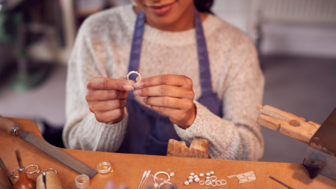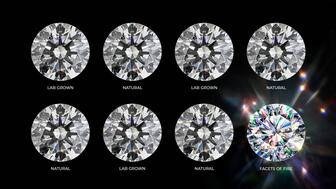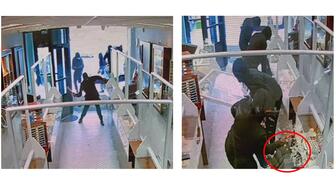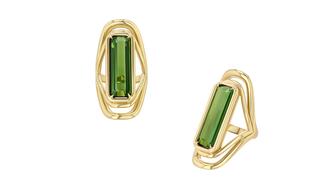A pink topaz Belle Époque pendant-brooch and a Victorian Egyptian Revival choker were also highlights at a recent Anderson & Garland sale.
De Beers Lab Introduces Screening Device for Set Jewelry
The International Institute of Diamond Grading & Research said it is the first device in the industry that can test multiple stones set in jewelry at once.
Las Vegas--The International Institute of Diamond Grading & Research just introduced what it says is the first screening device for man-made diamonds that can test multiple stones in set jewelry at once.
The De Beers Group-owned lab, which has facilities in the U.K., India and Belgium, previewed the device at the recent JCK Las Vegas show.
Called SYNTHdetect, it uses IIDGR’s patented luminescence technology to screen diamonds of all sizes that already have been set in rings, earrings, bangles, brooches and necklaces.
The IIDGR’s Christopher Sanger said what sets the device apart is its ability to test multiple diamonds at once and not have to screen them one by one.
“If you had a ring with 300 melee stones in it, you could test them as one, rather than a probe, where you’d have to individually do each one,” he told National Jeweler via email. “This is the unique thing about this new instrument, and something no other can do.”
The IIDGR said that the referral rate for SYNTHdetect--meaning the number of natural (mined) diamonds that erroneously get referred for further testing--is 0.05 percent, the lowest in the industry. (As with other detection instruments, any stones that are referred should be submitted to a grading lab for further testing.)
Intended for back-office use by jewelry manufacturers and retailers, it is priced at $16,250.
The SYNTHdetect machine is slightly bigger than a PC and has a touch-screen monitor. It will be available for distribution in the fall.
The device is the latest in a line of second-generation detection instruments for man-made diamonds developed by IIDGR, following on the heels of the PhosView last year, which is designed to scan parcels of diamonds, and the AMS2 this spring, the updated version of its automated melee screener.
It also is the second man-made diamond screening device for set jewelry introduced by a major laboratory this year.
Back in April, the Gemological Institute of America unveiled a prototype of a machine that tests both mounted and unmounted diamonds to separate HPHT- and CVD-grown diamonds from mined stones.
The GIA’s device, which will be available by the end of the year and cost between $4,000 and $5,000, tests gems one by one using a spectroscopic probe to examine the fluorescence spectra of each stone. The lab said it refers 100 percent of man-made diamonds.
The IIDGR is taking orders for SYNTHdetect now, with deliveries beginning
The Latest

The event, which will co-locate with the Monterey Bay Jade Festival, will bring education sessions focused on jade to the United States.

The charm is a celebration of springtime as April showers bring May flowers with the piece’s cluster of diamond raindrops.

Bench jewelers spend years honing their skills, Jewelers of America’s Certification validates their talents.

The National Retail Federation expects retail sales growth to return to pre-pandemic levels as consumers continue to face inflation.


The 4-carat, old mine brilliant-cut diamond engagement ring was co-designed by Willis and New York City-based brand Karina Noel.

Rio Tinto unearthed the diamond at its Diavik mine in Canada’s Northwest Territories.

Natural diamonds mean more than lab-grown, but when every cut is ideal, they all look the same. Customers want more—Facets of Fire delivers.

The multisensory experience, open April 8-13, will feature the brand’s silver creations among dream-like scenes of natural landscapes.

The virtual event will take place April 7 at 3 p.m.

The pieces in “Animali Tarallo” portray animals from stingrays to elephants through portraits and interpretations of their patterns.

Parent company Saks Global said the iconic location will be open through the holiday season as it decides what to do with the space.

Ronald Winston, son of Harry Winston, donated the diamonds to the Smithsonian National Museum of Natural History in Washington, D.C.

The educational event will take place in Charlotte, North Carolina, this May.

The independent jeweler first opened its doors in 1888.

The layoffs come amid the TV shopping channel’s efforts to restructure and focus on live shopping through social media.

The debut event will take place in Miami’s Coconut Grove neighborhood this fall.

The roundtable will take place May 17 ahead of the trade show’s welcome dinner.

The “Peanuts x Monica Rich Kosann” collection features the comic strip’s classic vocabulary across 10 bracelet designs.

Three industry experts dive into the complexities of the material often marketed as an “ethical” alternative for metal in jewelry.

Diamonds are not only one of the most prominent gemstones, but the birthstone for those born in April.

The Utah-based company known for making wedding bands has acquired Doubloon Golf.

The longtime luxury executive led one of LVMH’s watch brands, TAG Heuer, for 12 years before taking over Bulgari in 2013.

Authorities said the robbers fled with jewelry and 70 Rolex watches, later taking pictures of themselves posing with big stacks of cash.

Lotus Gemology founder Richard W. Hughes has translated Heinrich Fischer’s 1880 book “Nephrit und Jadeit” from its original German.

The ring's design features contrasting lines influenced by work from architecture-inspired photographer Nikola Olic.

The Conference Board’s index fell as consumers continued to worry about the impact of tariffs, the labor market, and the price of eggs.




























